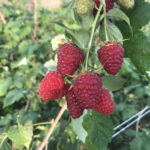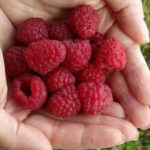Raspberry variety Himbo top
A wonderful Swiss variety of remontant raspberries called Himbo top has become known to domestic gardeners relatively recently, and is not yet very common in our country. However, its gastronomic, aesthetic and economic characteristics are so high that it leaves no doubt about its prospects of gaining genuine popularity among both farmers and amateurs.

The novelty was bred in the commune of Rafz, canton Zurich, by breeder Peter Hauenstein on the basis of crossing the varieties Autumn Bliss and Rafzeter. Initially, the author named his creation Rafzaqu, but later transferred the rights to the variety to Promo-Fruit AG, which began to promote it under the Himbo-Top® brand. This name is currently registered in Switzerland as an international trademark, as well as as a national trademark in a number of other countries.
The main advantages of this form of raspberry are high yield, the possibility of obtaining two harvests per season, extended fruiting period, comparative large fruit size and uniformity of berries, excellent taste characteristics and resistance to a number of diseases. The high quality of the variety confirms its zoning in many European countries and the USA, which are very scrupulous and demanding in matters of admission to the use of breeding novelties.
According to the originating company, which offers planting material for sale, the plants are tested every year in a specially organized test garden for the strength of growth, health, yield and quality of the fruit. Out of more than 50 bushes, only two of the best are used as “elite” plants for further propagation. This ensures that the original properties of the variety are not only maintained over time, but also gradually improved.
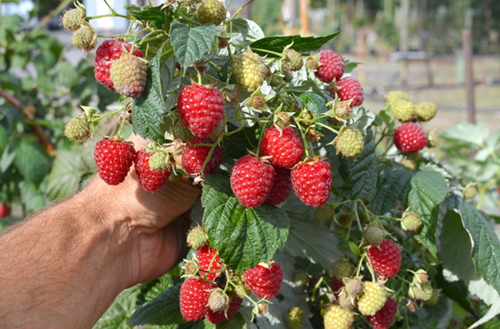
Agrobiological characteristics
The variety shows a powerful growth of annual shoots, reaching a height of 1.7-1.9 meters. The number of replacement shoots is small, however, due to the active growth of fruit branches on them, the productivity of raspberry bushes is very high. The laterals in Himbo tops begin to form at a distance of 40 cm from the surface of the earth and they grow up to 80 cm in length. In order to avoid breaking off under the weight of the crop, the lateral branches must be tied up or supported. On the surface of young shoots, purple thorns are formed, the intensity of the location of which varies depending on the height. Closer to the ground, they sit tightly in relation to each other, and as they move to the top they become rare, up to 5-7 pieces per 5 cm of shoot length. The thorns are rather short, which is why they do not interfere with the care of bushes and harvesting. Composite leaves grow strongly wrinkled, consisting of three or five leaf blades, the color of which can vary from turquoise to yellowish-green, depending on the soil and climatic conditions of cultivation. Veins are much lighter than the main leaf pigmentation. The leaflets are oval with a pointed end, the average size is 10-12 cm in length and 5-7 in width. The raspberry leaf blade is curved upward; its strong irregularity is observed along the edges.
The flowers of the variety are large, white, located on the peduncle with a slight anthocyanin shade, up to 20 mm in diameter, collected in highly branching brushes. The petals are 8-9 mm long, their shape is usually oval with a rounded edge. Sepals are sharp, up to 15 mm long, numbering 5 pieces. During flowering, the sepals lean forward strongly, and towards the end they bend back. Due to the large size of the flowers, the bushes acquire a very elegant appearance during flowering.
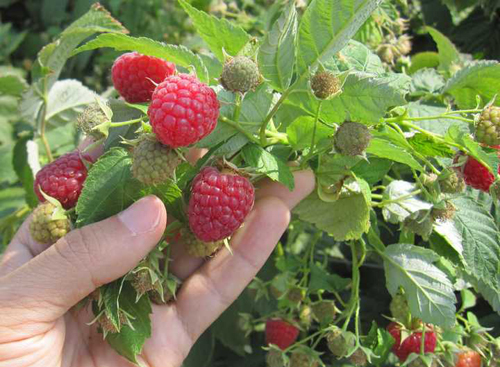
Ripening of berries occurs in two periods. In late June - early July, fruiting occurs on two-year shoots, and in August-September - on annuals.When cultivated in light film greenhouses, it is quite possible to continue harvesting raspberries in the month of October. Surprisingly, Himbo top alone is capable of creating a whole raspberry conveyor, bearing fruit at intervals, from mid-summer to late autumn. At the same time, the berries do not shrink until the very last harvest. In general, up to 3 kg of fruit can be obtained from a plant per season, and yield per hectare of plantations can reach 20 tons. It is a pleasure to collect these raspberries - large berries are easily separated from the stalk, but at the same time they do not crumble even if overexposed on the bushes.
The appearance of the harvested fruits of this variety is simply magnificent. Shiny, dark red, weighing 6-8 grams, they leave no one indifferent. Their pulp differs in density depending on the time of collection. The fruits of the first harvest, ripening on overwintered shoots, are usually relatively tender, while berries that are denser in consistency are formed on a one-year growth, which nevertheless remain very juicy and pleasant to chew. Their taste is very balanced and expressive, rather sweet, with a very subtle, barely discernible sourness, harmoniously complementing the sensation of food. The aroma is typical for the culture, its intensity is medium. The bones are practically invisible. Overall raspberry tasting ratings are consistently high.
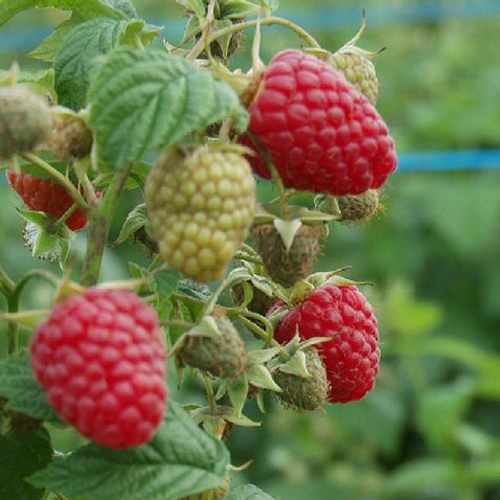
The Himbo crop top can be used in a variety of ways. The variety is excellent for fresh consumption and for processing. It can interest farmers with its "marketability", due to the excellent presentation and taste of berries, as well as amazing productivity. Buyers are eager to sort this variety, and it usually does not stay on the shelves. In addition, an important point is that the harvested berries do not darken for a long time, do not crumple, they have very good transportability and can be transported over fairly long distances without any special losses. As a raw material, our Swiss hero is used in the production of preserves, jams, marshmallows, confiture, confectionery and bakery products. Berries show themselves well when dried and shock-frozen. After thawing, raspberries retain their shape well.
In the process of cultivation, plants show themselves to be very unpretentious, and do not require complex self-care, even in the harsh domestic climate. First of all, the ability of Himbo top is noted to grow on all kinds of soil, both in terms of fertility and in terms of texture. Everywhere he demonstrates excellent growth power and pleases the owner with excellent productivity. The variety is one of the few that can grow on heavy, dense soils with their low water and air permeability. The second positive point is its increased resistance to fungal and bacterial diseases, as well as to pests. Due to this, this variety of raspberries in the West is often used in organic farming, in which plantations are minimally treated with plant protection products. The experience of domestic amateur gardeners also confirms the possibility of obtaining an environmentally friendly harvest. But the winter hardiness of the "Swiss" is not outstanding, and therefore its cultivation in frost-prone regions is possible only with a guaranteed high snow cover. In summer, it can withstand short-term droughts, however, for a consistently high productivity, it is also necessary to provide sufficient soil moisture.
Agrotechnical features
Despite its overseas origin, Himbo top does not require any specific cultivation process. In this regard, it is cultivated according to the usual schemes for remontants, taking into account the existing advantages and flaws in the agrobiology of the variety.
Ideal for planting are gentle slopes, the exposure of which is chosen depending on the climate. In the hot south, slopes are used mainly in cool directions, and in the north - warm ones. Plains are also quite suitable for raspberries, but it is better if they are protected from the winds by the features of the relief, since snow is often blown off the open plains in winter, as a result of which our not too frost-resistant hero risks dying. Soils, as already mentioned, are suitable for any, except for too acidic, saline, damp, and even more swampy.
Due to the high growth activity of the bushes of this variety, they need to provide sufficient space to facilitate their care and exclude unnecessary competition of plants for moisture, nutrients and sunlight. It is recommended to leave 2.5-3 meters between the rows, and 50-70 cm between the bushes in a row. Planting is carried out in spring or autumn, the main thing is that the plant is in a dormant phase at this time. Mandatory on the site equip a trellis for garter shoots and fruit twigs, bearing a bountiful harvest. They try to water the vegetative raspberry as needed, periodically combining this procedure with fertilizing with mineral fertilizers. The soil under the bushes of Himbo top is regularly weeded, and the two-year-old shoots that have borne fruit are removed in time. In frost-prone areas, annual shoots in the fall are bent to the ground to be covered with snow, or they are completely cut out, transferring the bushes only to late summer fruiting.
Harvesting is carried out in the morning, after the dew has dried, or in the evening. You should not use the sultry daytime for this, since the berries of such a collection will have the worst keeping quality and transportability. It is not recommended to put the collected raspberries in a bulk container, because despite its sufficient density, the berry in this case can be crumpled.




